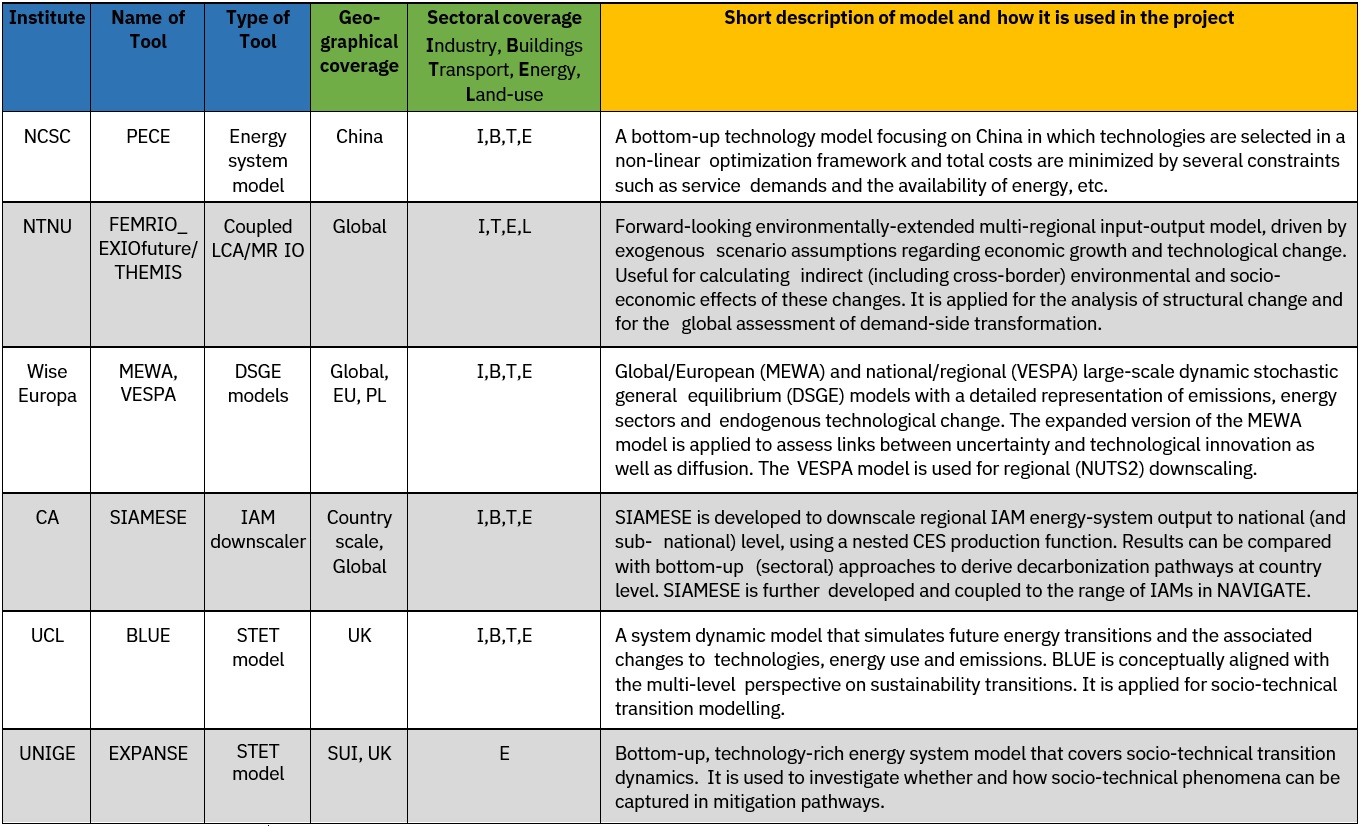PECE (NCSC)

Type of tool:
Energy system model
Geographical coverage:
China
Sectoral coverage:
industry, buildings, transport, energy
Description:
A bottom-up technology model focusing on China in which technologies are selected in a non-linear optimization framework and total costs are minimized by several constraints such as service demands and the availability of energy, etc.
Further information:
UNDP, China Human Development Report. 2009/10: China and a Sustainable Future: Towards a Low Carbon Economy and Society, ISBN 978-7-5001-2498-6
FEMRIO_ EXIOfuture/ THEMIS (NTNU)

Type of tool:
Coupled LCA/MR IO
Geographical coverage:
global
Sectoral coverage:
industry, transport, energy, land use
Description:
Forward-looking environmentally-extended multi-regional input-output model, driven by exogenous scenario assumptions regarding economic growth and technological change. Useful for calculating indirect (including cross-border) environmental and socio-economic effects of these changes. It is applied for the analysis of structural change and for the global assessment of demand-side transformation.
Further information:
Wiebe et al (2018) Implementing exogenous scenarios in a global MRIO model for the estimation of future environmental footprints. Journal of Economic Structures 7:20. doi: 10.1186/s40008-018-0118-y
MEWA/VESPA (Wise Europa)

Type of tool:
DSGE models
Geographical coverage:
global, EU, PL
Sectoral coverage:
industry, buildings, transport, energy
Description:
Global/European (MEWA) and national/regional (VESPA) large-scale dynamic stochastic general equilibrium (DSGE) models with a detailed representation of emissions, energy sectors and endogenous technological change. The expanded version of the MEWA model is applied to assess links between uncertainty and technological innovation as well as diffusion. The VESPA model is used for regional (NUTS2) downscaling.
Further information:
Bukowski, et al (2017) Analysis of selected OP IE measures at the sectoral and macroeconomic level using the interbranch flows model, WiseEuropa, Warsaw;
Bosello, et al (2016) Report on Economic Quantitative Ex-Ante Assessment of Proposed Policy Mixes in the EU. DYNAMIX project deliverable D6.2. Milan.
SIAMESE (CA)

Type of tool:
IAM downscaler
Geographical coverage:
global, country scale
Sectoral coverage:
industry, buildings, transport, energy
Description:
SIAMESE is developed to downscale regional IAM energy-system output to national (and sub- national) level, using a nested CES production function. Results can be compared with bottom-up (sectoral) approaches to derive decarbonization pathways at country level. SIAMESE is further developed and coupled to the range of IAMs in NAVIGATE.
Further information:
Sferra F et al (2019) Towards optimal 1.5°C and 2°C emission pathways for individual countries: a Finland case study”, Energy Policy
BLUE (UCL)

Type of tool:
STET model
Geographical coverage:
UK
Sectoral coverage:
industry, buildings, transport, energy
Description:
A system dynamic model that simulates future energy transitions and the associated changes to technologies, energy use and emissions. BLUE is conceptually aligned with the multi-level perspective on sustainability transitions. It is applied for socio-technical transition modelling.
Further information:
https://www.ucl.ac.uk/energy-models/models/blue
EXPANSE (UNIGE)

Type of tool:
STET model
Geographical coverage:
SUI, UK
Sectoral coverage:
energy
Description:
Bottom-up, technology-rich energy system model that covers socio-technical transition dynamics. It is used to investigate whether and how socio-technical phenomena can be captured in mitigation pathways.
Further information:
Trutnevyte (2016) Does cost optimization approximate the real-world energy transition? Energy 106:182–193. doi: 10.1016/j.energy.2016.03.038



